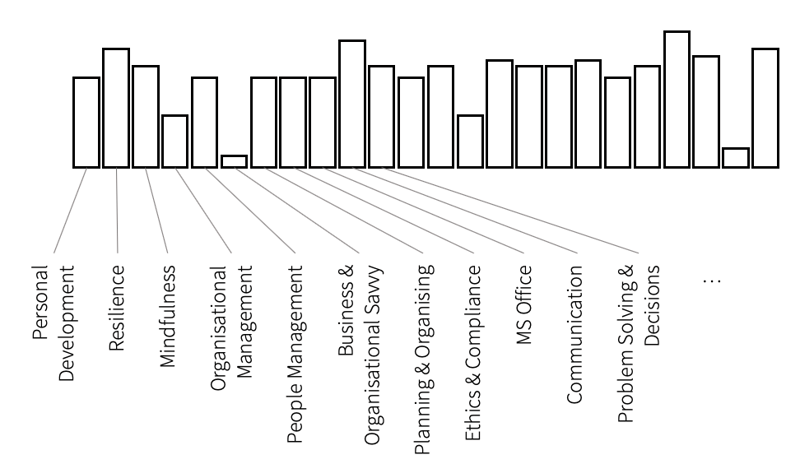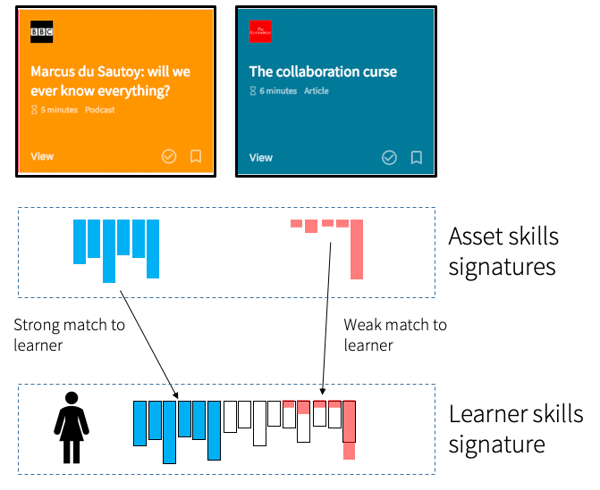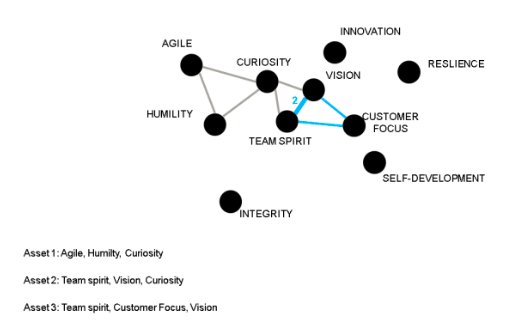Matching learners to learning content
magpie aims to match development needs we can identify in the learner with learning content recommendations that best meet those needs.
We describe those development needs in terms of a skills signature. For us a learner’s skills signature is a quantification of the importance of each skill to them - i.e. the extent to which building each skill will add value for the learner and for their organisation.
Graphically, an example of a skills* signature looks like this.

[*Note: we generally build a bespoke skills framework consultatively with each client, to support their business objectives. And while we use the jargon ‘skills signature’, it could just as easily cover knowledge areas, attributes, behaviours, as well as skills.]
Or if you prefer, mathematically, it’s just a set of numbers: {Personal Development, 0.8; Resilience, 0.9; Mindfulness, 0.84; …} for skills in a framework.
A learner’s skills signature is our live, continually updated best-estimate of which skills they can most valuably develop.
Once we have modelled a learner’s skills signature, magpie matches it with its model of the skills each piece of content (learning asset) is likely to develop. Where there is a good match - that is where the content builds skills that are particularly important to the learner - we will prioritise that content; where there is a mismatch we will de-prioritise.

Each item of content is prioritised based on how closely it matches our model of the learner, in terms of their respective skills signatures.
But how do we calculate the skills signatures in the first place?
Learner skills signature
A learner’s skills signature is modelled from the profile they build with us describing their role, objectives and interests, and their pattern of use of content.
On the profile-side, we use a database of profile information mapped to the skills they imply are important. The profile information might cover the sector a learner works in, their organisation’s department, their professional specialism, their experience, their managerial responsibility, their career, or development goals. Each of these profile elements will be mapped to skills in the framework, which are then aggregated (using a Bayesian average) to provide their profile-based personalised skills signature for the learner.
When the learner starts to engage with content, the skills that content is tagged to ‘rub off’ on the learner’s signature. magpie’s machine learning aggregates those skills too, forming a usage-based skills signature for the learner which is in turn blended with their profile-based signature. Usage consists of opening, launching, bookmarking, completing and leaving positive feedback on content. We experiment with the relative effect these interactions have, but currently, for example, bookmarking an asset has three times the effect of launching it, and rating an asset as useful has five times the effect.
Content skills signatures
To build skills signatures for learning content, we tag libraries of learning assets to skills frameworks, using a combination of manual, semi-manual and algorithmic methods. These tagged libraries allow us to deduce the connection between skills in the frameworks. For example if tags for ‘vision’ and ‘team spirit’ are frequently applied to the same assets, we deduce a correlation between the tags. The deduced connections are represented in our algorithm in the form of a knowledge graph - a network of linked skills, representing the strength of connection between each skill label.
In the below example with just three learning content assets, connections are deduced between some skills in a framework from the tags commonly applied to the same asset. A connection between ‘curiosity’ and ‘humility’ is deduced because asset 1 is tagged to both those skills. The fact that both asset 2 and asset 3 have been tagged with ‘team spirit’ and ‘vision’ means a stronger connection is inferred between those two.

This knowledge graph, together with the tagged library of content, allow us to cluster together related assets - assets which each build a common specialist skill combination. Assets labelled with the same skills, or skills that are closely related in the knowledge graph, are grouped.
Here’s a real example of four assets associated by the algorithm - these seem to address the subject ‘fostering and harnessing innovation’. The assets are linked by the explicit tag ‘Creativity’, which has been applied to all of them, but also by deduced relationships between for example ‘Planning & Organising’ and ‘Business Savvy & Commerciality’.

Once assets are clustered in this way, all the skills tags across all the assets in a cluster are counted, and the count then forms the skills signature for each asset in the cluster. In this way machine learning supplements manual or pre-existing tagging, enabling more nuanced recommendations. And as we add new assets to a library they benefit from the existing structure of the knowledge graph and clustering, so curation is automatic.
Future capabilities
We have work in progress which will greatly broaden the range of learning opportunities magpie can support - by integrating much more flexibly with other platforms, by accepting a much wider variety of learner characteristics as inputs, and more automatically ingesting new content. Watch this space!

